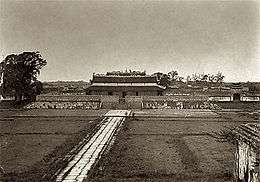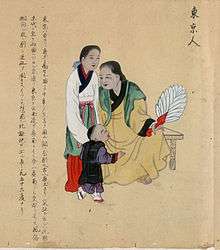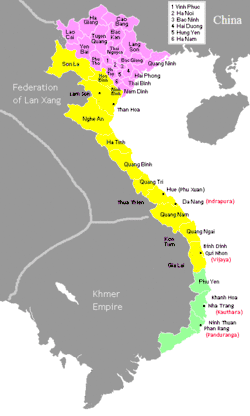Lê dynasty
| Kingdom of Đại Việt Đại Việt Quốc (大越國) | |||||||||
|---|---|---|---|---|---|---|---|---|---|
|
1427–1527 1533–1789 | |||||||||
.png) Đại Việt at its greatest extent under the reign of Emperor Lê Thánh Tông. Light area represents area briefly conquered from 1478–1480, blue area represents vassal Champa states. | |||||||||
| Status | Empire | ||||||||
| Capital | Đông Kinh | ||||||||
| Common languages | Vietnamese | ||||||||
| Religion | Neo-Confucianism, Buddhism, Taoism | ||||||||
| Government | Monarchy | ||||||||
| Emperor | |||||||||
• 1428–1433 | Lê Lợi (first) | ||||||||
• 1522–1527 | Lê Cung Hoàng (tenth) | ||||||||
• 1786–1789 | Lê Chiêu Thống (last) | ||||||||
| History | |||||||||
• Coronation of Lê Lợi | 15 March 1427 | ||||||||
| 15 June 1527 | |||||||||
| January 1789 | |||||||||
| Currency | Văn (Sapèque) | ||||||||
| |||||||||
| Today part of |
| ||||||||
The Later Lê dynasty (Vietnamese: Nhà Hậu Lê; Chữ Hán: 後黎朝), sometimes referred to as the Lê dynasty (the earlier Lê dynasty ruled only for a brief period (980–1009)), was the longest-ruling dynasty of Vietnam, ruling the country from 1428 to 1788, with a brief six-year interruption of the Mạc dynasty usurpers (1527–1533). Vietnamese historians usually distinguish the 100-year Primitive Lê Dynasty (1428 to 1527) from 256-years of figurehead emperors of the Restored Lê Dynasty (1533 to 1789) following the dynasty's restoration by powerful warlords.[lower-alpha 1]
The dynasty officially began in 1428 with the coronation of Lê Lợi after he drove the Ming army from Vietnam. In 1527, the Mạc dynasty usurped the throne; when the Lê dynasty was restored in 1533, they still had to compete for power with the Mạc dynasty during the period known as Southern and Northern Dynasties. The restored Lê emperors held no real power, and by the time the Mạc dynasty was confined to only a small area in 1592 and finally eradicated in 1677, actual power was in the hands of the Nguyễn lords in the South and the Trịnh lords in the North, both ruling in the name of the Lê emperor while fighting each other. Their rule officially ended in 1788, when the peasant uprising of the Tây Sơn brothers defeated both the Trịnh and the Nguyễn, ironically in order to restore power to the Lê dynasty.
The Lê dynasty's rule saw Vietnam's territories grow from a small state in northern Vietnam at the time of Lê Lợi's coronation into almost its current size by the time the Tây Sơn brothers took over. It also saw massive changes to Vietnamese society: the previously Buddhist state became Confucian after 20 years of Ming rule. The Lê emperors instituted many changes modeled after the Chinese system, including the civil service and laws. Their long-lasting rule was attributed to the popularity of the early emperors. Lê Lợi's liberation of the country from 20 years of Ming rule and Lê Thánh Tông's bringing the country into a golden age was well-remembered by the people. Even when restored Lê emperors' rule was marked by civil strife and constant peasant uprisings, few dared to openly challenge their power, at least in name, for fear of losing popular support. When the Mạc dynasty tried to do so, they were not successful and were considered as usurpers and not recorded in official histories by later dynasties.
Lê Thái Tổ and Founding of the Lê dynasty
The founder of the Lê dynasty was the hero-Emperor of Vietnam, Lê Lợi (ruled 1428–1433). Lê Lợi was the son of a village leader in Thanh Hóa Province, the southern-most province of Vietnam at the time. When he was born, Vietnam was independent and under the rule of the Trần dynasty. However, the Trần Emperors had been weak for some decades and the powerful neighbor to the north, China was now unified and under the rule of the energetic founder of the Ming dynasty, the Hongwu Emperor. As was usual in Vietnamese history, a disputed succession was an excuse for the Chinese to re-assert control over Vietnam (See the Hồ dynasty for further details). The Chinese, now under the Yongle Emperor conquered and ruled Vietnam starting in 1407. They immediately tried to change it into another province of the Ming Empire. Many, if not all Vietnamese customs and laws were declared invalid. Distinctive features of Vietnamese life which had naturally emerged during the nearly 500 years of independence from China were suppressed. All resistance to this effort was treated as rebellion and was dealt with according to normal Imperial Chinese methods (villages were burned, people were tortured and executed).
Lê Lợi started a revolt against the Ming rulers in 1418. The revolt lasted for 10 years during which there was much bloodshed and many defeats. However, the Chinese were gradually beaten and finally Lê Lợi was victorious. He proclaimed himself the new Emperor of Vietnam, gave himself the name Lê Thái Tổ (the Founding Emperor), and was recognized as such by the new Xuande Emperor of China. However, after only five years on the throne, Lê Lợi became ill and died.
Lê Thái Tông

Lê Thái Tông (ruled 1433–1442) was the official heir to Lê Lợi, but he was only 11 years old. As a result, a close friend of Lê Lợi, Lê Sát, assumed the regency of the kingdom. Not long after he assumed the official title as Emperor of Vietnam in 1438, Lê Thái Tông accused Lê Sát of abuse of power and had him executed.
According to a Mạc–Trịnh version of Complete Annals of Đại Việt, the new Emperor had a weakness for women. He had many wives, and he discarded one favorite after another. The great scandal was his affair with Nguyễn Thị Lộ, the wife of his father's chief advisor Nguyễn Trãi. The affair started early in 1442 and continued when the Emperor traveled to the home of Nguyễn Trãi, who was venerated as a great Confucian scholar.
Shortly after the Emperor left Trãi's home to continue his tour of the western province, he fell ill and died. At the time the powerful nobles in the court argued that the Emperor had been poisoned to death. Nguyễn Trãi was executed as were his three entire relations (the normal punishment for treason).
Lê Nhân Tông
With the sudden death of the Emperor at a young age, his heir was an infant son named Bang Co. He was the second son of his father but the elder son Nghi Dân had been officially passed over due to his mother's low social status. Bang Co was renamed Lê Nhân Tông (Vietnamese: Lê Nhân Tông; ruled: 1442–1459) but the real rulers were Trịnh Khả and the child's mother, the young Empress Nguyễn Thị Anh. The next 17 years were good years for Vietnam – there were no great troubles either internally or externally. Two things of note occurred: first, the Vietnamese sent an army south to attack the Champa kingdom in 1446; second, the Dowager Empress ordered the execution of Trịnh Khả, for reasons lost to history, in 1451.
Two years later (1453), at the age of twelve, Lê Nhân Tông was formally given the title of Emperor. This was unusual as according to old customary, youths could not ascend the throne till the age of 16. It may have been done to remove the Dowager Empress Nguyễn Thi Anh from power, but if that was the reason, it failed, and the young emperor's mother still controlled the government up until a coup in 1459.
In 1459, Lê Nhân Tông's older brother, Nghi Dân, plotted with a group of followers to kill the Emperor. On October 28, the plotters with some 100 "shiftless men" infiltrated the palace and murdered the Emperor (he was just 18). The next day, facing certain execution the Dowager Empress committed suicide. The rule of Nghi Dân was brief, and he was never officially recognized as a sovereign by later Vietnamese historians. Revolts against his rule started almost immediately and the second revolt, occurring on June 24, 1460, succeeded. The rebels, led by the last of Lê Lợi's former advisors (Nguyễn Xí and Dinh Liêt), captured and killed Nghi Dân along with his followers. The rebels then selected the youngest son of Lê Thái Tông to be the new Emperor. His posthumous name is Lê Thánh Tông and he was just 17 years old at the time.
Lê Thánh Tông
.png)
Lê Thánh Tông (ruled 1460–1497) was the most prominent of all the Lê rulers and one of the greatest Emperors in Vietnamese history. His rule was one of the high points in the history of Vietnam, the time of a "Flood of Virtue" (Hồng Đức), and he has been referred to as the Vietnamese Hammurabi. He instituted a wide range of government reforms, legal reforms, and land reforms. He restarted the examination system for selecting men for important government positions. He reduced the power of the noble families and reduced the degree of corruption in the government. He built temples to Confucius throughout the provinces of Vietnam. In nearly all respects, his reforms mirrored those of the Song dynasty.
He led a large and effective army against the Champa and captured the Cham capital, ending the power of the Champa forever. He created a new province out of former Champa land and allowed settlers to go to the new land.
Decline of the Lê dynasty
With the death of Lê Thánh Tông, the Lê dynasty fell into a swift decline (1497–1527).
Lê Hiến Tông (ruled 1497–1504)
Prince Lê Tăng, the eldest of Lê Thánh Tông's 14 sons, succeeded his father as Lê Hiến Tông. He was 38 years old at the time of his father's death. He was an affable, meek and mild-mannered person. Due to his short period of rule and that he didn't pass many significant reforms, his reign is considered to be an extension of Lê Thánh Tông's rule.
Lê Túc Tông (ruled 1504–1505)
Lê Hiến Tông chose his third son, Lê Túc Tông to be his successor. The 17 year-old Lê Túc Tông was portrayed by court chroniclers as a wise emperor who maintained harmony in the court. However, he fell gravely ill and died just six months after assuming the throne.
Lê Uy Mục (ruled 1505–1509)
His older brother succeeded Lê Túc Tông as Lê Uy Mục. The first thing the new emperor did was to take revenge against those who had barred him from the throne by having them killed. Among his victims were the former emperor's mother – which was considered a shocking display of evil behavior. Lê Uy Mục was described as a cruel, sadistic, and depraved person, who wasted the court's money and finances to indulge his whims. Well aware that he was detested by his subjects, Lê Uy Mục protected himself by hiring a group of elite bodyguards to surround him at all times. Among them was Mạc Đăng Dung, who became very close to the emperor and eventually rose to the rank of general. Despite his precautions, in 1509 a cousin, whom Lê Uy Mục had put in prison, escaped and plotted with court insiders to assassinate the emperor. The assassination succeeded and the killer proclaimed himself emperor under the name Lê Tương Dực.
Lê Tương Dực (ruled 1510–1516)
Lê Tương Dực proved to be just as bad a ruler as Lê Uy Mục. He reigned from 1510 to 1516, all the while spending down the royal treasury, and doing nothing to improve the country. He was heedless to the reaction that his taxes caused throughout the country. His rule ended in 1516 when a group of officials and generals stormed the palace and killed him.
Civil war
At barely 14 years old, nephew of Lê Tương Dực, prince Lê Y, was enthroned as the new emperor Lê Chiêu Tông (ruled 1516–1522). As usual when a young Emperor came to the throne, factions within the court vied with one another for control of the government. One powerful and growing faction was led by Mạc Đăng Dung. His growing power was resented by the leaders of two noble families in Vietnam: the Nguyễn, under Nguyễn Hoàng Dụ and the Trịnh, under Trịnh Duy Đại and Trịnh Duy Sản. After several years of increasing tension, the Nguyễn and the Trịnh left the capital Hanoi (then called Đông Đô) and fled south, with the Emperor "under their protection".

This was the start of a civil war with Mạc Đăng Dung and his supporters on one side and the Trịnh and the Nguyễn on the other side. Thanh Hóa Province, the ancestral home to the Trịnh and the Nguyễn, was the battle ground between the two sides. After several years of warfare, Emperor Lê Chiêu Tông was assassinated 1522 by Mạc Đăng Dung's supporters. Not long after, the leaders of the Nguyễn and the Trịnh were executed. Mạc Đăng Dung was now the most powerful man in Vietnam.
In the region of Hưng Hoá, Tuyên Quang the brothers Vũ Văn Mật, Vũ Văn Uyên or Vu (Bau lords) (Vietnamese:Chúa Bầu) got out of the control of the Trịnh and called themselves Bau lords. They showed strong support for the Lê dynasty and refused to accept Trịnh family at the early stage of Trịnh–Nguyễn War. Later, they cooperated with the Trịnh. Bau lords lasted for nearly 200 years from 1527 to 1699.
Mạc Đăng Dung usurps the throne

The degenerated Lê dynasty, which endured under six rulers between 1497 and 1527, in the end was no longer able to maintain control over the northern part of the country, much less the new territories to the south. The weakening of the monarchy created a vacuum that the various noble families of the aristocracy were eager to fill. Soon after Lê Chiêu Tông fled south with the Trịnh and the Nguyễn in 1522, Mạc Đăng Dung proclaimed the Emperor's younger brother, Le Xuan, as the new Emperor under the name Lê Cung Hoàng. In reality, the new Emperor had no power. Three years after Mạc's forces killed his older brother, Lê Chiêu Tông, Mạc Đăng Dung ended the fiction that Lê Cung Hoàng actually ruled by killing him (in 1527). Mạc Đăng Dung, being a scholar-official who had effectively controlled the Le for a decade, then proclaimed himself the new Emperor of Vietnam in 1527, ending (so he thought) the Lê dynasty (see Mạc dynasty for more details).
Mạc Đăng Dung's seizure of the throne prompted other families of the aristocracy, notably the Nguyễn and Trinh, to rush to the support of the Le. With the usurpation of the throne, the civil war broke out anew. Again the Nguyễn and the Trịnh gathered an army and fought against Mạc Đăng Dung, this time under the leadership of Nguyễn Kim and Trịnh Kiểm. The Trịnh and the Nguyễn were nominally fighting on behalf of the Lê emperor but in reality, for their own power.
See also
Notes
References
Sources
- Ooi, Keat Gin (2004). Southeast Asia: A Historical Encyclopedia, From Angkor Wat to East Timor. ABC-CLIO. ISBN 978-1576077702.
| Preceded by Fourth Chinese domination of Vietnam |
Dynasty of Vietnam 1428–1527 |
Succeeded by Mạc dynasty |
| Preceded by Mạc dynasty |
Dynasty of Vietnam 1533–1788 |
Succeeded by Tây Sơn dynasty |